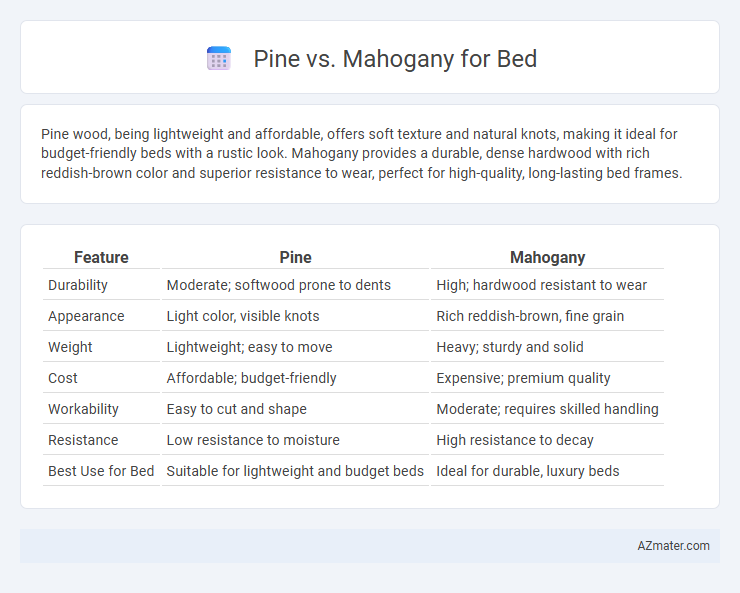Pine wood, being lightweight and affordable, offers soft texture and natural knots, making it ideal for budget-friendly beds with a rustic look. Mahogany provides a durable, dense hardwood with rich reddish-brown color and superior resistance to wear, perfect for high-quality, long-lasting bed frames.
Table of Comparison
| Feature | Pine | Mahogany |
|---|---|---|
| Durability | Moderate; softwood prone to dents | High; hardwood resistant to wear |
| Appearance | Light color, visible knots | Rich reddish-brown, fine grain |
| Weight | Lightweight; easy to move | Heavy; sturdy and solid |
| Cost | Affordable; budget-friendly | Expensive; premium quality |
| Workability | Easy to cut and shape | Moderate; requires skilled handling |
| Resistance | Low resistance to moisture | High resistance to decay |
| Best Use for Bed | Suitable for lightweight and budget beds | Ideal for durable, luxury beds |
Introduction: Choosing the Right Wood for Your Bed
Selecting the right wood for your bed impacts durability, aesthetics, and comfort, making Pine and Mahogany two popular choices with distinct qualities. Pine offers affordability and a light, rustic charm with its softwood properties, while Mahogany provides exceptional strength and rich, deep hues as a premium hardwood. Understanding the grain patterns, hardness levels, and maintenance requirements of Pine versus Mahogany helps in making an informed decision tailored to both style and longevity.
Overview of Pine and Mahogany
Pine is a softwood known for its affordability, light color, and natural knots, making it a popular choice for rustic or casual bed designs. Mahogany is a dense hardwood prized for its rich reddish-brown hue, durability, and fine grain, often used in high-end, elegant furniture. Both woods offer distinct aesthetics and performance characteristics, with pine being lighter and easier to work, while mahogany provides superior strength and long-lasting beauty.
Appearance and Aesthetic Differences
Pine beds feature a lighter, more rustic appearance with prominent knots and a soft grain that enhances a cozy, natural aesthetic ideal for cottage or farmhouse styles. Mahogany beds offer a rich, deep reddish-brown color and a fine, straight grain, providing a luxurious, elegant vibe suited to traditional or classic interiors. The visual warmth of mahogany contrasts with pine's brightness, making each wood choice distinct in creating either casual or refined bedroom ambiances.
Durability and Hardness Comparison
Pine wood is a softwood with a Janka hardness rating of approximately 380, making it more prone to dents and scratches compared to mahogany. Mahogany is a hardwood with a Janka hardness rating around 900, offering superior durability and resistance to wear over time. Beds constructed from mahogany provide long-lasting structural integrity and maintain their appearance better in high-use environments.
Weight and Handling Considerations
Pine beds are significantly lighter than mahogany, making them easier to handle, move, and assemble, which is ideal for frequent relocations or room adjustments. Mahogany, being a dense hardwood, offers superior durability but results in heavier furniture that can be cumbersome to shift without assistance. Choosing pine ensures affordability and ease of handling, while mahogany provides long-lasting stability at the cost of increased weight.
Cost and Affordability
Pine beds are significantly more affordable than mahogany, making them a popular choice for budget-conscious buyers seeking quality furniture. Mahogany beds, known for their rich color and durability, command higher prices due to the wood's density and long-lasting nature. Cost-wise, pine offers excellent value with lower material and manufacturing expenses, ideal for those prioritizing affordability without sacrificing aesthetic appeal.
Maintenance and Longevity
Pine beds require more frequent maintenance due to their softer wood, making them prone to dents and scratches, but they are easier to refinish and repair. Mahogany beds offer superior longevity with their dense, durable hardwood structure, resisting wear and warping over time, which reduces the need for frequent upkeep. Investing in mahogany ensures a long-lasting bed with minimal maintenance, while pine suits those preferring cost-effectiveness and simpler refinishing tasks.
Environmental Impact and Sustainability
Pine is a fast-growing softwood that supports sustainable forestry practices due to its high regeneration rate and lower carbon footprint during production. Mahogany, a slow-growing hardwood, often involves deforestation and habitat loss, raising concerns about illegal logging and reduced biodiversity. Choosing pine beds contributes to responsible resource use and aligns better with environmental sustainability goals compared to mahogany.
Best Uses: Pine vs Mahogany in Bedroom Furniture
Pine is ideal for bedroom furniture offering affordability, lightweight durability, and a rustic, natural aesthetic that complements casual or cottage-style decor. Mahogany provides superior strength, rich color, and elegant grain patterns, making it perfect for heirloom-quality beds and classic, sophisticated bedroom designs. Pine suits budget-friendly and easy-to-paint or stain options, while mahogany excels in long-lasting luxury furniture pieces requiring high durability.
Conclusion: Which Wood is Better for Your Bed?
Pine wood offers affordability, lightness, and a natural aesthetic ideal for budget-conscious buyers seeking a rustic or casual bedroom style. Mahogany provides superior durability, rich color, and an elegant finish, making it the preferred choice for long-lasting, high-end furniture with a classic look. Selecting between pine and mahogany depends on priorities such as budget, desired durability, and style preferences for your bed frame.

Infographic: Pine vs Mahogany for Bed
 azmater.com
azmater.com